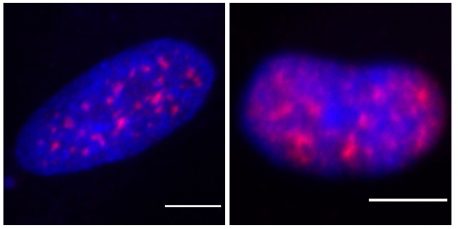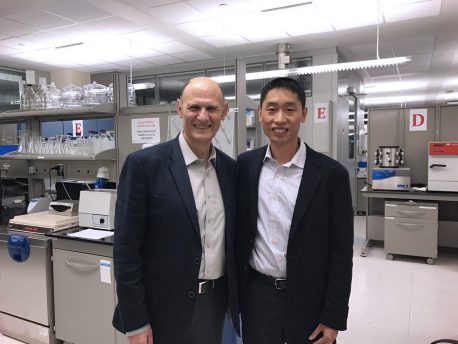
July 13, 2022
Findings could lead to new treatments for Wiskott-Aldrich syndrome
Findings could lead to new treatments for Wiskott-Aldrich syndrome
LA JOLLA—Researchers at the Salk Institute and King Abdullah University of Science and Technology (KAUST) in Saudi Arabia have discovered a new underlying cause of Wiskott-Aldrich syndrome, a rare genetic disease that leads to bleeding and immune deficiencies in babies. Their findings, published in the journal Nature Communications on June 25, 2022, revolve around how cells cut and paste strands of RNA in a process called RNA splicing. The genetic mutations associated with Wiskott-Aldrich syndrome, they found, disrupt this process which, in turn, prevents numerous immune and anti-inflammatory proteins from being made correctly.

“This study not only suggests new targets for treating Wiskott-Aldrich syndrome with small molecule drugs, but also sheds new light on the basic biology of RNA splicing, an important and not fully understood process,” says co-corresponding author Juan Carlos Izpisua Belmonte, a professor in Salk’s Gene Expression Laboratory and holder of the Roger Guillemin Chair.
Babies with Wiskott-Aldrich syndrome begin to develop symptoms quickly after birth: itchy, scaly rashes, frequent bruises and nose bleeds are some of the first signs. Over time, they become prone to infections and are more likely than other children to develop autoimmune diseases and cancers. The only potential cure is a bone marrow transplant, which carries a host of complications and only works in some children.
Scientists have long known that Wiskott-Aldrich syndrome is caused by mutations in a gene on the X chromosome; the gene and the protein it encodes were named WASP after the syndrome. The WASP protein is found throughout cells in the blood and immune system, and one of its functions is to maintain these cells’ cytoskeletons, the microscopic networks of proteins that give cells their shape and organization. But changes to the cytoskeleton couldn’t explain all the symptoms.
Former Salk Postdoctoral Fellow Mo Li, now the head of KAUST’s Laboratory of Stem Cell and Regeneration, and Izpisua Belmonte wondered if WASP plays other roles—particularly in the nuclei of blood and immune cells, where genetic material is stored and processed.
To find out, they removed the WASP gene from stem cells and coaxed the cells to become macrophages or B cells, two types of immune cells impacted by the disease. They also collected cells from two patients with Wiskott-Aldrich syndrome and generated induced pluripotent stem cells (iPSCs) containing the disease-associated mutations in WASP. Then they compared the altered cells to normal macrophages and B cells.

“These are powerful models that can help us understand how WASP functions and what the underlying cellular mechanisms of Wiskott-Aldrich syndrome are,” says Li.
Immune cells lacking WASP, or containing mutations in the WASP gene, appeared different right away; there were many more clusters—known as nuclear speckles—in the centers of diseased cells. For a protein to be produced by a cell, the DNA encoding it is first transcribed into a strand of RNA. Often, this initial strand contains more genetic material than is needed; this is where RNA splicing comes in. Proteins in nuclear speckles cut and paste bits of the initial RNA strand into its final instructions for a protein.
“When we saw differences in the nuclear speckles of these cells, this is the first time we realized that WASP might be involved in RNA splicing,” says Baolei Yuan, a KAUST graduate student and first author of the new paper.
The researchers also showed that many proteins related to RNA splicing were present at higher levels in the cells lacking WASP or with mutations in WASP. WASP both controlled the production of these RNA-splicing factors and directly played a role in RNA splicing itself. The team pinpointed thousands of other genes with altered RNA splicing—many were related to inflammation, autoimmunity and cancer.
Additional experiments revealed that repairing WASP mutations fixes these RNA splicing defects. What’s more, lowering levels of an RNA-splicing factor, SRSF2, can prevent the problems. These results suggest that drugs targeting SRSF2 could treat Wiskott-Aldrich syndrome in humans, the researchers say.
“These RNA splicing factors could both be a biomarker for monitoring Wiskott-Aldrich syndrome, and a potential target for treatment,” says Izpisua Belmonte.
More work is needed to understand exactly how WASP is splicing RNA, as well as which symptoms of Wiskott-Aldrich syndrome are associated with the abnormal RNA splicing seen in diseased cells.
Izpisua Belmonte is currently Institute Director of Altos Labs Inc., in addition to being a professor at the Salk Institute.
Other authors include Keiichiro Suzuki, Sarah Dunn, Reyna Hernandez-Benitez, Tomoaki Hishida, Na Young Kim, Manching Ku, Yuta Takahashi, Ling Huang, Christopher Benner, Emi Aizawa, Zhongwei Li, Fei Yi, Maxim Shokhirev and Concepcion Rodriguez Esteban of Salk; Xuan Zhou, Gerardo Ramos-Mandujano, Mengge Wang , Muhammad Tehseen , Lorena V. Cortés-Medina, Manal M. Andijani, Chongwei Bi, Jinna Xu, Yanal Ghosheh and Samir Hamdan of KAUST; James J. Moresco and John R. Yates of Scripps Research Institute; Jinsong Qiu, Changwei Shao and Xiang-Dong Fu of UC San Diego; Jing Qu and Guang-Hui Liu of the Chinese Academy of Sciences; Patrizia Comoli of Fondazione IRCCS Policlinico San Matteo; and Francesco Frassoni of Instituto G. Gaslini Children Hospital Scientific Institute.
The work was supported in part by the KAUST Office of Sponsored Research (BAS/1/1080-01 and URF/1/4716-01), Waitt Advanced Biophotonics Core Facility of the Salk Institute with funding from NIH-NCI CCSG (P30 014195), NINDS Neuroscience Core Grant, Waitt Foundation, National Key Research and Development Program of China (2020YFA0804000), Strategic Priority Research Program of the Chinese Academy of Sciences (XDA16010000), National Natural Science Foundation of China (81921006, 92149301, 92168201), Moxie Foundation, and G. Harold and Leila Y. Mathers Charitable Foundation.
DOI: 10.1038/s41467-022-31220-8
JOURNAL
Nature Communications
AUTHORS
Baolei Yuan, Xuan Zhou, Keiichiro Suzuki, Gerardo Ramos-Mandujano, Mengge Wang, Muhammad Tehseen, Lorena V. Cortés-Medina, James J. Moresco, Sarah Dunn, Reyna Hernandez-Benitez, Tomoaki Hishida, Na Young Kim, Manal M. Andijani, Chongwei Bi, Manching Ku, Yuta Takahashi, Jinna Xu, Jinsong Qiu, Ling Huang, Christopher Benner, Emi Aizawa, Jing Qu, Guang-Hui Liu, Zhongwei Li, Fei Yi, Yanal Ghosheh, Changwei Shao, Maxim Shokhirev, Patrizia Comoli, Francesco Frassoni, John R. Yates III, Xiang-Dong Fu, Concepcion Rodriguez Esteban, Samir Hamdan, Mo Li and Juan Carlos Izpisua Belmonte
Office of Communications
Tel: (858) 453-4100
press@salk.edu
Unlocking the secrets of life itself is the driving force behind the Salk Institute. Our team of world-class, award-winning scientists pushes the boundaries of knowledge in areas such as neuroscience, cancer research, aging, immunobiology, plant biology, computational biology and more. Founded by Jonas Salk, developer of the first safe and effective polio vaccine, the Institute is an independent, nonprofit research organization and architectural landmark: small by choice, intimate by nature, and fearless in the face of any challenge.